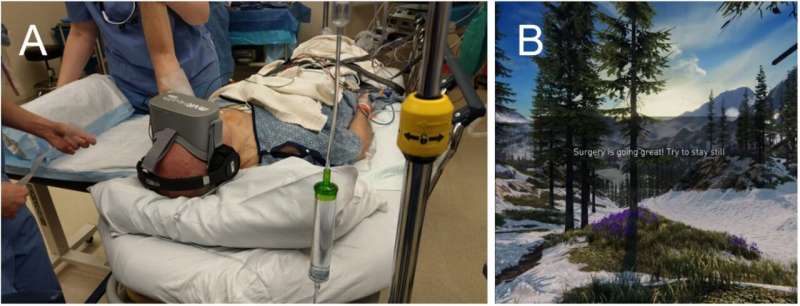VR in the OR: Virtual reality found to reduce need for sedation during hand surgery

With conditions such as carpal tunnel syndrome and osteoarthritis on the rise, U.S. hand surgeons perform more than half a million procedures each year. Patients undergoing hand surgery commonly receive a regional anesthetic to block pain prior to the procedure, plus monitored anesthesia care (MAC) during the operation. MAC typically consists of an IV-administered sedative—such as propofol—to keep patients feeling sleepy and calm during procedures but awake enough to follow instructions as needed. Too much sedation, however, can lead to low blood pressure, upper airway obstruction and potentially serious complications such as stroke, heart attack or respiratory failure.
In a novel attempt to reduce the risks of over sedation, physician-scientists at Beth Israel Deaconess Medical Center (BIDMC) have conducted a randomized controlled trial to determine whether virtual reality immersion can minimize the need for sedatives during hand surgery without negatively impacting patient satisfaction. The team studied adults undergoing hand surgery who were randomized to receive either Virtual Reality (VR) immersion during the procedure in addition to usual MAC, or usual MAC alone. They found that VR immersion during hand surgery led to significant reductions in sedative doses as well as post-operative lengths of stay in the post anesthesia care unit (PACU). Their work is published in PLOS ONE.
"With the increase in the amount of time people spend at the keyboard combined with our aging population, there is a projected increased need for common elective hand surgeries," said senior author Brian P. O'Gara, MD, MPH, an anesthesiologist in the Department of Anesthesia, Critical Care and Pain Medicine at BIDMC. "Optimizing care for these patients will undoubtedly involve modification to anesthetic practices. Virtual reality's purported benefit in the management of patients with pain or anxiety is through providing an immersive experience capable of distracting the mind from processing the unpleasantries associated with undergoing surgery."
O'Gara and colleagues enrolled 34 adults who underwent hand surgery with regional anesthesia at BIDMC between December 2018 and August 2019. Patients who received VR wore headsets and noise-canceling headphones, and selected the programming of their choice from several immersive 360-degree VR environments designed to promote relaxation and calmness, such as a meadow, forest or mountain top. For both groups, supplemental anesthetics and/or pain medications could be administered either upon patient request or at the discretion of the anesthesia provider according to their clinical judgment. No investigators were assigned to be the anesthesia provider of study participants in either group, nor were study team members present in the operating room to conduct any research activities for control group patients.
The scientists' results revealed that patients in the VR group received significantly less propofol than those in the control group—a median of 260 mg less propofol per case than patients in the usual care group. Notably, only four of the 17 patients in the VR group received any propofol during their procedure, while every patient in the control group received the sedative. However, significantly more patients in the VR group received supplemental local anesthesia by the surgeon than in the control group, suggesting that the preoperative nerve block is very important to the success of the VR technique.
In follow-up questionnaires administered in the PACU after surgery, patients' self-reported outcomes revealed no significant differences between the VR and control groups in overall satisfaction. Additionally, patients in both groups said their pain was well-controlled and that they felt relaxed during their surgery. There were also no significant differences between the groups' PACU pain scores, peri-operative opioid doses. Strikingly, however, the VR group were discharged from the PACU after their surgery an average of 22 minutes earlier than their counterparts in the control group. At one month after surgery, there were no differences found between groups in their functional outcomes as it related to hand function.
"Our trial is novel in that it is the first to report a significant reduction in sedative dosing with VR immersion during hand surgery on adults," said O'Gara, who is also an assistant professor in anesthesia at Harvard Medical School. "Using VR immersion, the potential harms of unnecessary sedation can be avoided without compromising patient comfort during hand surgery. Furthermore, we saw that VR group patients were discharged from the PACU 22 minutes earlier than control patients. A reduction in PACU stay could help optimize perioperative efficiency if the VR technique were used more widely."
More information: Adeel A. Faruki et al, Virtual reality immersion compared to monitored anesthesia care for hand surgery: A randomized controlled trial, PLOS ONE (2022). DOI: 10.1371/journal.pone.0272030




















